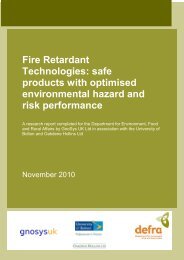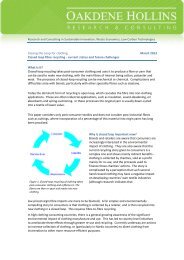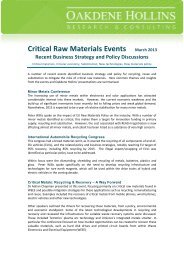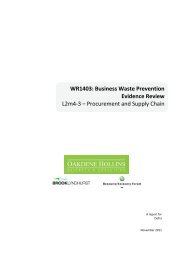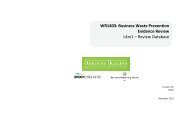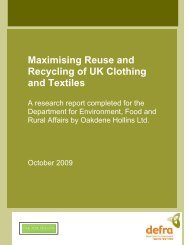Recycling of Low Grade Clothing Waste - Oakdene Hollins
Recycling of Low Grade Clothing Waste - Oakdene Hollins
Recycling of Low Grade Clothing Waste - Oakdene Hollins
You also want an ePaper? Increase the reach of your titles
YUMPU automatically turns print PDFs into web optimized ePapers that Google loves.
© <strong>Oakdene</strong> <strong>Hollins</strong> Ltd, Salvation Army Trading Company Ltd<br />
Nonwovens Innovation & Research Institute Ltd September 2006<br />
• The study finds that a “national wardrobe” exists which represents a<br />
considerable tonnage <strong>of</strong> latent waste material. It is necessary to<br />
establish the actual level <strong>of</strong> this stock.<br />
• Many LCA studies focus on carbon impacts <strong>of</strong> waste streams. We<br />
should consider the case for economic instruments for clothing from a<br />
resource conservation, rather than a pollution, impact perspective<br />
(which is the traditional driver for producer responsibility measures).<br />
• There is little evidence <strong>of</strong> “closed loop” recycling, whereby recycled<br />
fibres are used in the manufacture <strong>of</strong> new clothing in the place <strong>of</strong> virgin<br />
fibres. Based on the experience <strong>of</strong> the paper making industry, it is<br />
important to understand the reasons for this and to undertake<br />
comparative LCA studies.<br />
• To improve understanding <strong>of</strong> the secondary market dynamics it is<br />
important to determine the degree to which second hand clothing acts<br />
a substitute for new clothing in secondary markets.<br />
• The technical and market development work in this project, which has<br />
reached the stage <strong>of</strong> identifying a number <strong>of</strong> new high value<br />
applications for recycled textiles, requires to be continued. More<br />
investment is needed to turn these into commercial reality. We need to<br />
view these items as a raw material and show “industry” how to make<br />
use <strong>of</strong> them.<br />
• A key point is the collection system. This not only applies to textiles but<br />
increasingly to all secondary use materials. We need to understand the<br />
true economies <strong>of</strong> resource management and not just look at the<br />
collection cost, but the overall cost to UK plc.<br />
• Textile manufacturers, designers, retailers and the secondary textile<br />
industry need to be encouraged to work together to address, and to<br />
develop solutions to, the issues raised by this report. To this end some<br />
projects are identified for further collaborative work aimed at<br />
improving the sustainability <strong>of</strong> the wider textile industry.<br />
For Defra Page 14



